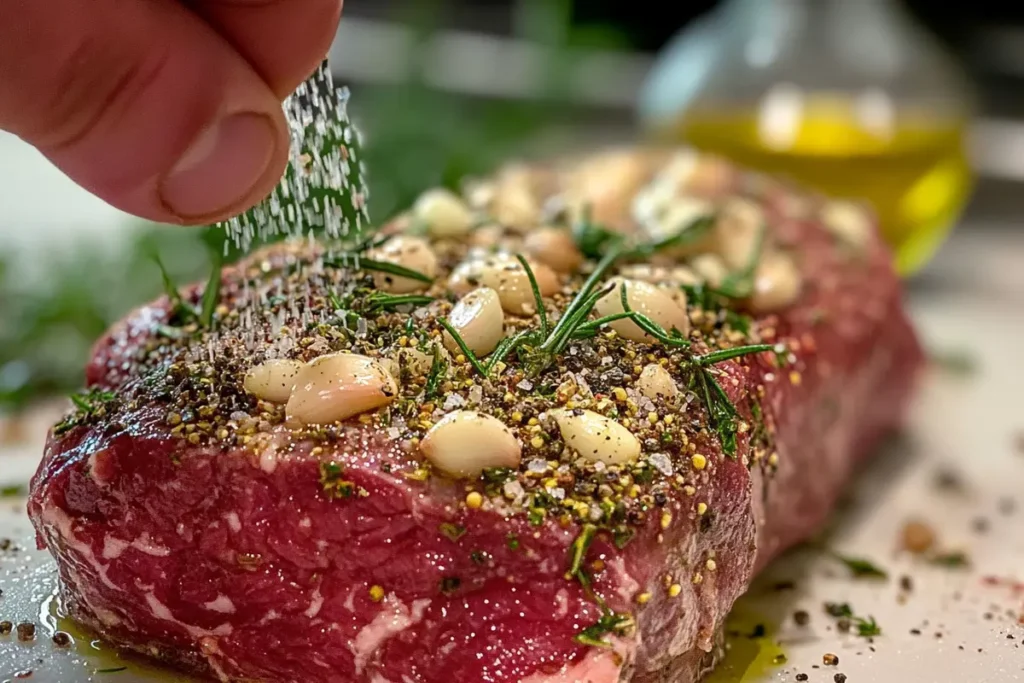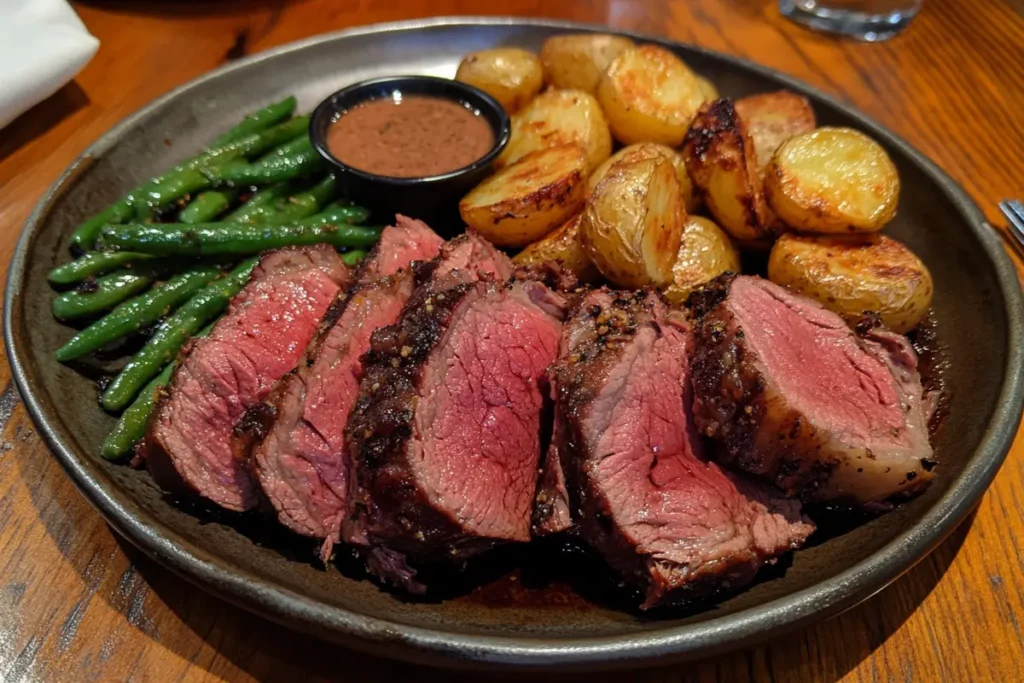Classic Roast Beef – The Quintessential Recipe and Guide
Roast beef is a culinary classic that has not only stood the test of time but also remained a favorite at Sunday dinners, holiday feasts, and special occasions. As one of the most versatile dishes, it continues to grace tables with its rich flavors and timeless appeal. In this article, we’ll take you on a flavorful journey through everything you need to know about preparing classic roast beef. Whether you’re selecting the perfect cut, mastering essential cooking techniques, or pairing it with delectable sides, this guide has you covered. Moreover, you’ll uncover the secrets to achieving tender, juicy roast beef that’s sure to impress everyone at the table. So, without further ado, let’s dive right in!
Introduction to Classic Roast Beef
What is Classic Roast Beef?
Classic roast beef is a timeless dish that embodies hearty and flavorful dining. It’s a whole beef cut, slow-roasted to perfection, bringing out the natural juiciness and rich, meaty flavors. The recipe is renowned for its simplicity, relying on quality ingredients and proper technique to achieve a dish that’s both comforting and elegant.
Historical Significance and Origin
The tradition of roast beef dates back centuries, with its roots in British culinary history. Often served as the centerpiece of Sunday roasts in England, the dish symbolizes familial gatherings and festive occasions. Over time, classic roast beef has transcended its origins to become a global favorite, with variations found in different cuisines worldwide.
Why Roast Beef Remains a Staple in Culinary Traditions
What makes roast beef so special? Its versatility and simplicity. Whether seasoned with just salt and pepper or enhanced with a complex rub, this dish adapts to countless flavor profiles. Roast beef also pairs beautifully with traditional sides like Yorkshire pudding, roasted vegetables, and rich gravies, making it a staple for meals that celebrate togetherness and comfort.
Selecting the Perfect Cut for Roast Beef
Overview of Ideal Beef Cuts for Roasting
When it comes to making Classic Roast Beef, choosing the right cut is crucial for a tender and juicy result. Cuts like rib roast, sirloin tip, and tenderloin are top choices because they’re well-marbled, ensuring natural moisture and flavor. For a more budget-friendly option, try top round or bottom round, but make sure to cook these cuts slowly to maintain tenderness.
Choosing Between Grass-fed and Grain-fed Beef
Grass-fed beef offers a leaner texture and a rich, earthy flavor, while grain-fed beef is prized for its consistent marbling and buttery taste. Both work beautifully for Classic Roast Beef, but your choice depends on flavor preference and availability. Whichever you choose, be sure to adjust your cooking technique to suit the fat content for the best results.
Key Considerations: Fat Content, Marbling, and Thickness
To create the perfect roast, look for a cut with even marbling, as these fine streaks of fat melt during cooking and enhance the beef’s natural flavor. The thickness of the roast also matters—opt for a cut at least 2 inches thick to ensure even cooking.

Preparing Your Roast Beef
The Essential Marinade Ingredients and Process
A flavorful marinade can elevate your Classic Roast Beef from good to exceptional. Combine olive oil, minced garlic, rosemary, thyme, salt, and pepper for a classic base. Add a splash of balsamic vinegar or a dollop of Dijon mustard for extra depth. Rub this mixture evenly over the beef and let it sit in the refrigerator for at least 4-6 hours, or overnight for a more robust flavor.
Techniques for Proper Seasoning
Seasoning is where simplicity often shines. Generously coat the beef with kosher salt and freshly ground black pepper right before roasting. For an added flavor twist, sprinkle smoked paprika or onion powder. Be sure to pat the beef dry before seasoning to ensure a crusty, caramelized exterior.
Resting and Preparing the Meat Before Cooking
Allow the roast to come to room temperature for 30-60 minutes before cooking. This step helps the beef cook evenly and avoids a raw center. While the roast rests, preheat your oven or prepare your cooking method. Once the beef has acclimated to room temperature, it’s ready for roasting.
Cooking Methods for Roast Beef
Classic Oven Roasting – Step-by-Step Guide
Oven roasting remains the traditional and most popular method for making Classic Roast Beef. To begin, preheat your oven to 325°F (163°C). Place the seasoned roast on a wire rack inside a roasting pan, allowing heat to circulate for even cooking. Insert a meat thermometer into the thickest part of the beef to monitor doneness. Aim for these internal temperatures:
- Medium-rare: 135°F (57°C)
- Medium: 145°F (63°C)
Once cooked, let the roast rest under foil for 15-20 minutes to lock in the juices before slicing. This method ensures a perfectly moist and flavorful result.
Modern Cooking Tools: Using Slow Cookers and Sous Vide
For a hands-off approach, try slow cooking. First, sear the beef in a hot skillet to enhance flavor, then place it in a slow cooker with vegetables and broth. Cook on low for 6-8 hours until the beef is tender.
Sous vide, a modern cooking technique, guarantees even cooking and juicy results. Seal the beef in a vacuum bag, cook in a water bath at a precise temperature, and finish with a quick sear in a hot pan. It’s perfect for ensuring consistent doneness throughout the roast.
Common Mistakes to Avoid During Cooking
Rushing the resting phase or skipping the thermometer are common pitfalls when making Classic Roast Beef. Always let the beef rest and use a thermometer to prevent overcooking. Avoid carving immediately, as this can cause juices to escape, leaving the meat dry.
For more delicious recipes like this, check out our guide to slow-cooked beef dishes.
Part 5: Slicing and Serving Roast Beef

How to Properly Slice Roast Beef for Maximum Tenderness
The way you slice Classic Roast Beef can truly make or break the dish. To start, use a sharp carving knife to ensure clean cuts and always slice against the grain. This technique breaks down the muscle fibers, making every bite tender and easy to chew. Additionally, aiming for uniform, thin slices adds a touch of elegance to the presentation, making the roast look as good as it tastes.
Popular Sauces and Gravies to Complement Roast Beef
Pairing your roast with the right sauce can take the meal to the next level. For instance, a classic option is a rich pan gravy made from the beef’s drippings, which enhances the natural flavors of the roast. Furthermore, creamy horseradish sauce or a bold red wine reduction can provide a delightful contrast, adding depth to the dish. Together, these additions make Classic Roast Beef even more satisfying and memorable.
Serving Suggestions: Pairing with Vegetables and Sides
To complete your meal, consider sides that balance and complement the robust flavors of Classic Roast Beef. For traditional pairings, roasted potatoes, steamed green beans, and Yorkshire pudding are timeless choices. However, for a lighter touch, a fresh salad or roasted root vegetables can bring brightness and variety to the plate. No matter which sides you choose, the right combination will elevate your roast beef dinner into a well-rounded feast.
Looking for more sides to serve with your roast? Don’t miss our recipe collection featuring easy-to-make accompaniments.
Nutritional Value of Roast Beef
Protein and Essential Nutrients in Beef
Classic roast beef is not just delicious but also packed with essential nutrients. It’s a powerhouse of high-quality protein, which supports muscle growth and repair. A single serving of roast beef provides essential vitamins like B12, which helps with energy production, and minerals such as iron and zinc that boost immunity and overall health.
Healthy Preparation Tips
While roast beef is inherently rich and flavorful, you can make it even healthier by trimming excess fat before cooking. Opt for leaner cuts like sirloin tip or eye of round to reduce saturated fat content. Additionally, season with herbs and spices instead of heavy sauces to keep the dish light without sacrificing taste. Pairing roast beef with plenty of vegetables adds fiber and balances out the meal.
Balancing Roast Beef in a Balanced Diet
As with any protein-rich food, moderation is key. Incorporate classic roast beef into a balanced diet by enjoying it alongside whole grains, leafy greens, and other nutrient-dense foods. The result is a well-rounded meal that satisfies your taste buds while supporting your health goals.
FAQs About Classic Roast Beef
How Do I Keep Roast Beef Juicy?
Maintaining juiciness is all about technique. Use a meat thermometer to prevent overcooking, and always let the beef rest for 15-20 minutes after cooking. This allows the juices to redistribute evenly, ensuring every bite of your classic roast beef is tender and moist.
What is the Best Temperature for Cooking Roast Beef?
The ideal cooking temperature depends on your preferred level of doneness. For medium-rare roast beef, aim for 135°F (57°C) internally, while medium is best at 145°F (63°C). A consistent oven temperature of 325°F (163°C) ensures the beef cooks evenly without drying out.
Can Roast Beef Be Prepared in Advance?
Absolutely! You can prepare classic roast beef ahead of time by marinating it the night before. Once cooked, store it in an airtight container in the refrigerator for up to three days. When reheating, use low heat to preserve its tenderness and flavor.
How Long Can Cooked Roast Beef Be Stored?
Cooked roast beef can be safely stored in the refrigerator for 3-4 days. If you want to keep it longer, freeze it in airtight containers or vacuum-sealed bags. When stored properly, frozen roast beef retains its quality for up to three months.
People Also Ask (PAA) Questions
What Cut of Meat is Best for Roast Beef?
The cut of meat you choose significantly impacts the outcome of your classic roast beef. For the most tender and flavorful results, opt for cuts like rib roast, tenderloin, or sirloin tip roast. These cuts have excellent marbling, which ensures juiciness. For a more economical option, top round and bottom round are great choices but may require careful cooking to avoid dryness.
How Do You Make Roast Beef Tender?
Tenderness in classic roast beef depends on cooking methods and preparation. Start by choosing a well-marbled cut of beef. Searing the outside before roasting locks in moisture and adds a flavorful crust. Cooking slowly at a low temperature ensures even cooking. Finally, allow the roast to rest after cooking to let the juices redistribute.
What is the Traditional Temperature for Roast Beef?
Traditional roasting temperatures for beef vary depending on doneness preference. Medium-rare roast beef is achieved at 135°F (57°C), while medium requires 145°F (63°C). Maintaining an oven temperature of 325°F (163°C) throughout ensures the roast cooks gently and evenly.
Can You Freeze Cooked Roast Beef?
Yes, you can! Properly storing classic roast beef in the freezer keeps it fresh for up to three months. To freeze, slice the beef into portions, wrap tightly in plastic wrap or foil, and store in an airtight container. When ready to enjoy, thaw overnight in the refrigerator and reheat gently to preserve its texture and flavor.
Conclusion and Final Thoughts
Bringing It All Together
Classic roast beef is more than just a meal—it’s a celebration of tradition, flavor, and togetherness. With the right cut, thoughtful preparation, and careful cooking techniques, you can create a dish that’s as satisfying to make as it is to eat. Whether it’s served during a holiday feast or a cozy Sunday dinner, roast beef always brings a touch of elegance to the table.
Why Classic Roast Beef Deserves a Spot on Your Menu
Its simplicity, versatility, and rich flavor make classic roast beef a timeless favorite. From tender slices paired with rich sauces to hearty leftovers for sandwiches, this dish adapts beautifully to various occasions. So, gather your ingredients, fire up the oven, and enjoy the rewarding process of creating this culinary masterpiece.

